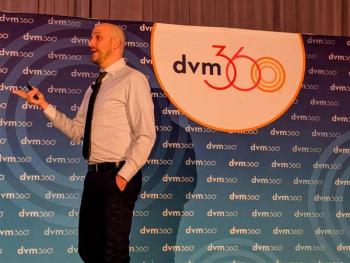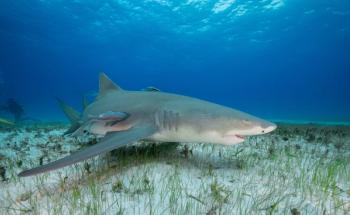
How many radiographs should you take and why? (Proceedings)
Take as many views as you need to in order to define a lesion or feel confident the lesion can not be defined using this technology.
What I Know
• Take as many views as you need to in order to define a lesion or feel confident the lesion can not be defined using this technology.
• Try to remove superimposition of structures when possible.
• Remove artifacts such as motion, debris on the hair, technical.
• Try to enhance contrast when possible.
The Airways and the Lungs
1. The number of radiographic projections required to define a lesion will depend on the extent and location of the lesion. The Common Views Are:
A. Ventrodorsal Projection:
• Sternum towards the X-ray tube, vertebrae against cassette or on the table.
• Used to evaluate the cranial mediastinum, ventral contour of the heart and ventral lung region.
B. Dorsoventral Projection:
• Vertebrae towards the X-ray tube, sternebrae against cassette or on the table.
• Used to evaluate the caudal mediastinum, overall contour of the heart, the aorta and the dorsal lung region.
• In both projections, the beam is centered on the fifth thoracic vertebra, the vertebrae and sternebrae are Superimposed, The Elbows Are Adducted And The Skin Folds Are Moved Laterally.
C. Right Lateral Projection:
• Left lateral surface of the torso is toward the X-ray tube, the right lateral surface of the torso is against the cassette.
• Used to evaluate the left lung field, mediastinal structures, left side of the diaphragm, esophagus and pericardial sac.
D. Left Lateral Projection:
• Right lateral surface of the torso is toward the X-ray tube, the left lateral surface of the torso is against the cassette.
• Used to evaluate the right lung field, mediastinal structures, right side of the diaphragm and pericardial sac. Used to evaluate for a hiatal hernia after barium administration.
• In both projections the beam is centered on the fifth intercostal space, the sternum is lifted slightly away from table, the forelimbs are pulled forward and the skin folds are moved dorsally and/or ventrally.
E. Oblique Projection:
• Use to remove superimposition
• Use to "highlight" an area
2. Radiographs of the thorax are usually obtained during inspiration unless you suspect pneumothorax or free pleural fluid. Free gas or fluids are easier to define when the animal is in expiration.
The lung, when viewed in expiration, is often mistakenly diagnosed as being pathologic. When the animal is in expiration, there is less gas in the lung and the lung becomes more opaque. This physiologic change results in increased lung opacity that mimics many disease processes that also cause the lung to become more opaque.
Air/gas is the natural contrast agent of the lung: take advantage of this contrast agent by radiographing the animal in inspiration when you wish to evaluate lung parenchyma, the pericardial sac, mediastinal structures and the diaphragm.
When the animal is in expiration, the pulmonary vessels are closer together, the diaphragm overlaps the heart, the cranial lung lobes do not extend to the thoracic inlet and the pericardial sac appears larger.
The Abdomen
2. The number of radiographic projections required to define a lesion will depend on the extent and location of the lesion and the contrast study/studies performed.
3. The common views are:
A. Ventrodorsal Projection
• Sternum towards the X-ray tube, vertebrae against cassette or on the table.
• Good for an overall evaluation of the abdominal viscera-generally better to take this projection than th dorsoventral projection for an overall view.
• Good to define the pylorus, duodenum and assess pancreatic region especially if there is gas in the stomach and duodenum.
• Often does not define lesions in thin, sleek pets
B. Dorsoventral Projection
• Vertebrae towards the X-ray tube, sternebrae against cassette or on the table.
• >Gives an overall evaluation of the abdominal viscera-generally not as good as the ventrodorsal projection to see the abdominal viscera.
• >Good to see the pylorus, duodenum and pancreatic region after patient giving GI positive contrast medium.
C. Right Lateral Projection
• Left lateral surface of the torso is toward the X-ray tube, the right lateral surface of the torso is against the cassette.
• Good general overview of the abdomen
• Good to evaluate the renal parenchyma, left side of the spleen, left side of the stomach, pancreas and liver
• Fluid accumulation in the pylorus can mimic a soft tissue opacity mass lesion.
• Good to evaluate for gastric torsion
D. Left Lateral Projection:
• Right lateral surface of the torso is toward the X-ray tube, the left lateral surface of the torso is against the cassette of the torso is against the cassette.
• Good general overview of the abdomen
• Good to evaluate the right side of the spleen, right side of the stomach, pancreas and liver and the duodenum.
E. Oblique Projection:
• Use to remove superimposition
• Use to "highlight" an area
The Skull
A. right or left lateral views:
• Good to obtain and overall view of the head
• Good to assess the nasopharynx/larynx
• Good to evaluate the contour of the calvarium
B. Ventrodorsal Or Dorsoventral Views:
• Good to obtain and overall view of the head
• Good to see the contour of the zygomatic arches, mandible, TM joints, and temporal bones/external ear canals
C. Rostrocaudal View:
• Good to see the dorsum of the calvarium
• Good to see the frontal sinuses
• Good to see the nasal septum/passages
• Good for bullae
D. Oblique Projections:
• Use to remove superimposition
• Use to "highlight" an area
• Good for dental arcades
• Good for bullae
Appendicular Skeleton
Terminology
• Limb-the entire appendage
• Leg-from the elbow distally
• from the stifle distally
• Craniocaudal
• Caudocranial
• Medial-Lateral
• Lateral-Medial
• Dorsopalmar
• Palmarodorsal
• Dorsoplantar
• Plantarodorsal
• Craniolateral-caudomedial oblique
• Caudomedial-craniolateral oblique
• Craniomedial-caudolateral oblique
• Caudolateral-craniomedial oblique
• Dorsolateral-palmaromedial oblique
• Palmaromedial-dorsolateral oblique
• Dorsomedial-palmarolateal oblique
• Palmaromedial-dorsolateral oblique
• Dorsolateral-planteromedial oblique
• Planteromedial-dorsolateral oblique
• Dorsomedial-planterolateral oblique
• Planterolateral-dorsomedial oblique
• Stress views
o Two views at right angle to each other are required to confirm joint congruity.
o The medial to lateral view is an important component of assessing most joints especially the stifle joint.
o The craniocaudal/caudocranial/dorsopalmar/dorsoplantar view is an important component of assessing most joints especially the elbow joint.
o The caudocranial/palmarodorsal view is an important component of assessing the hock.
o Stress views where pressure is applied to supportive ligaments during the radiographic procedure is an important component of assessing supportive soft tissue continuity.
Newsletter
From exam room tips to practice management insights, get trusted veterinary news delivered straight to your inbox—subscribe to dvm360.





